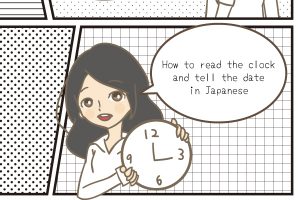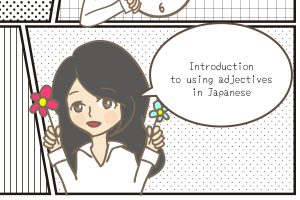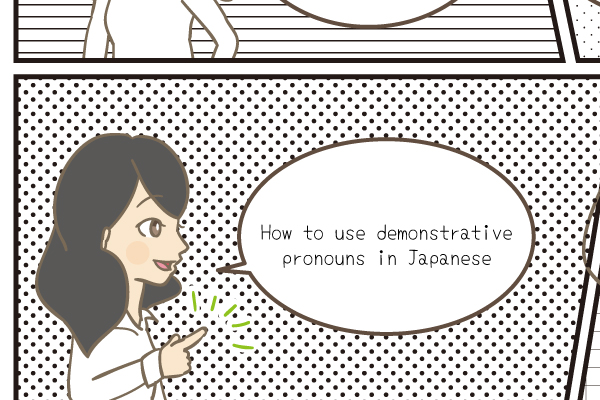How to use demonstrative pronouns in Japanese
Last time you learned how to tell the date and time in Japanese. For this video and article, we are leveling up to take a look at “指示詞” – demonstrative pronouns in Japanese. As in most languages, demonstrative pronouns are something you will use fairly often, so try and remember them with Shiho and our latest article!
| Table of Contents [Demonstrative pronouns] [The difference between “こ”, “そ”, and “あ”] |
[Demonstrative pronouns]
The main demonstrative pronouns in the Japanese language are “これ”, “それ”, and “あれ”. The first syllable or Hiragana letter of each pronoun is the local signifier and is used in every form of the Japanese pronoun. Here are some of the most commonly used demonstrative pronouns:
| これ、それ、あれ | This, that, that |
| ここ、そこ、あそこ | Here, there, there |
| こちら、そちら、あちら | (formal) This way/here, that way/there, that way/over there |
| こっち、そっち、あっち | (informal) This way/here, that way/there, that way/over there |
“こちら”, “そちら”, “あちら” and “こっち”, そっち“”, and “あっち” have the same meaning, but the first set is more formal than the second. You could use them in the following way:
| こちらへどうぞ。 | This way please. |
| こっち来て! | Come here! |
Here are a few more demonstrative pronouns you can try using:
| こう、そう、ああ | In this way/such, in that way/such, in that way/such |
| こんなに、そんなに、あんなに | Like this, like that, like that |
| このように、そのように、あのように | In this way, in that way, in that way |
| こうやって、そうやって、ああやって | Like this, like that, like that |
The above pronouns are mostly used with verbs and actions. The following six pronouns can be directly placed in front of a noun as an indicator:
| この+noun, その+noun、あの+noun | This noun, that noun, that noun |
| こんな+noun、そんな+noun、あんな+noun | Such a noun, such a noun, such a noun |
For example, you could use them in the following way:
| このペンはいいですね。 | This pen is good. |
| こんなペンが欲しいです。 | I would like such a/this kind of pen. |
[adsense]
[The difference between “こ”, “そ”, and “あ”]
Now, we haven’t really gotten into what the difference between “こ”, “そ”, and “あ” is. When you look at the translations above, a lot of them end up being the same or very similar – but there are very important distinctions between “こ”, “そ”, and “あ” which must be kept in mind when using them.
All in all, there are two major ways to use “こ”, “そ”, and “あ”.
1. “こ”, “そ”, and “あ” signify something or someone that is present at the time of talking
In this case, the difference between the three is as follows:
こ ー Signifies something/someone near to the speaker
そ ー Signifies something/someone near to the listener
So an example could go like this:
| Aさん:これは誰のペンですか? | A: Whose pen is this? |
| Bさん: それはあいさんのペンです。 | B: That is Ai’s pen. |
So, can you figure out where the pen is located in this scenario? If you can, then you have gotten the hang of it!
(The pen is near speaker “A”.)
あ ー Signifies something far away from both speaker and listener
Example:
| Aさん:あの人は誰ですか? | A: Who is that person? |
| Bさん:あの人はたかし先生です。 | B: That person is teacher Takashi. |
2. “こ”, “そ”, and “あ” signify things that are being referred to when talking or remembering something
This is the second way in which “こ”, “そ”, and “あ” can be used to distinguish between things while talking. In this case, the difference between the three is as follows:
こ ー Signifies something the speaker is about to talk about, or something that is already being talked about
This may be a bit hard to grasp, so try the following example:
| Aさん: Bさん、ちょっと相談に乗ってくれますか? | A: Can I talk to you about something? |
| Bさん: いいよ。 | B: Yes, of course. |
| Aさん: でも、この話は誰にも言わないでね。 | A: But please don’t tell anyone about this conversation. |
A is about to mention something, not a physical object, but a conversation or topic he is about to start. That’s why, in this case, he uses the demonstrative pronoun “この(+noun)”.
そ ー Signifies something that the person talking just mentioned, or when the listener is referring to something the speaker mentioned which they had not known previously.
| Aさん: ねえねえ、すずきさんが結婚するらしいよ。 | A: Hey, did you know Suzuki is going to get married? |
| Bさん: ええ?それ、本当? | B: What? Is that true? |
B did not know the fact A mentioned previously, hence B is surprised and refers to the fact of Suzuki getting married as “それ”.
あ ー Signifies something that both the person talking and the listener already know about. It can also refer to something the person talking remembers.
| Aさん: 今日のお昼はまたあのレストランに行こうよ。 | A: Let’s go to that restaurant again for lunch today. |
| Bさん: いいよ。今日もあれ食べようかな。 | B: Sure. Maybe I’ll have what I had last time. |
Both A and B know about the restaurant, since they have been there before. B uses “あれ” to refer to a dish he had at that restaurant before, hence remembering it.
| 指示詞 | Demonstrative pronouns |
| 名詞 | Noun |
| 指す | To indicate, to point out |
| 例文 | Example sentence |
| 質問 | Question |
| 相談に乗る | To give advice |
| 結婚 | Wedding |
| (お)昼 | Noon, lunch |

How to read the clock and tell the date in Japanese

Introduction to using adjectives in Japanese



